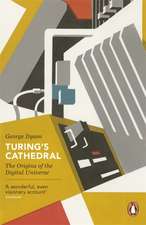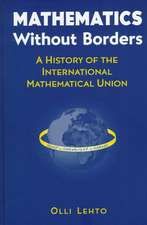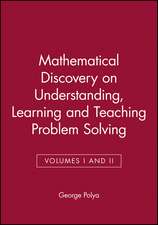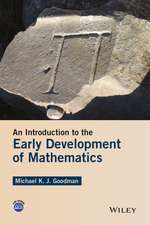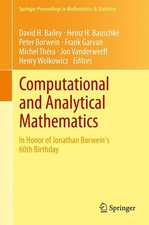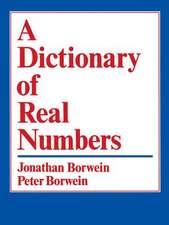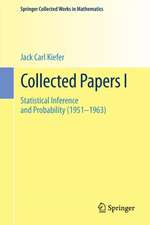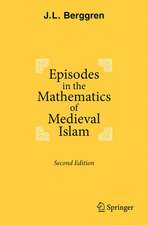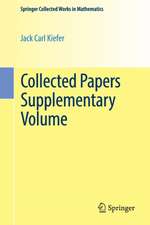Pi: A Source Book
Autor J. L. Berggren, Jonathan Borwein, Peter Borweinen Limba Engleză Hardback – 17 iun 2004
For this new edition, the authors have updated the original material while adding new material of historical and cultural interest. There is a substantial exposition of the recent history of the computation of digits of pi, a discussion of the normality of the distribution of the digits, and new translations of works by Viete and Huygen.
Preț: 1743.48 lei
Preț vechi: 2126.20 lei
-18% Nou
Puncte Express: 2615
Preț estimativ în valută:
333.61€ • 349.25$ • 276.04£
333.61€ • 349.25$ • 276.04£
Carte tipărită la comandă
Livrare economică 05-19 aprilie
Preluare comenzi: 021 569.72.76
Specificații
ISBN-13: 9780387205717
ISBN-10: 0387205713
Pagini: 797
Ilustrații: XIX, 797 p.
Dimensiuni: 178 x 254 x 42 mm
Greutate: 1.62 kg
Ediția:3rd ed. 2004
Editura: Springer
Colecția Springer
Locul publicării:New York, NY, United States
ISBN-10: 0387205713
Pagini: 797
Ilustrații: XIX, 797 p.
Dimensiuni: 178 x 254 x 42 mm
Greutate: 1.62 kg
Ediția:3rd ed. 2004
Editura: Springer
Colecția Springer
Locul publicării:New York, NY, United States
Public țintă
Popular/generalDescriere
This book documents the history of pi from the dawn of mathematical time to the present. One of the beauties of the literature on pi is that it allows for the inclusion of very modern, yet accessible, mathematics. The articles on pi collected herein include selections from the mathematical and computational literature over four millennia, a variety of historical studies on the cultural significance of the number, and an assortment of anecdotal, fanciful, and simply amusing pieces.
For this new edition, the authors have updated the original material while adding new material of historical and cultural interest. There is a substantial exposition of the recent history of the computation of digits of pi, a discussion of the normality of the distribution of the digits, new translations of works by Viete and Huygen, as well as Kaplansky's never-before-published "Song of Pi."
From the reviews of earlier editions:
"Few mathematics books serve a wider potential readership than does a source book and this particular one is admirably designed to cater for a broad spectrum of tastes: professional mathematicians with research interest in related subjects, historians of mathematics, teachers at all levels searching out material for individual talks and student projects, and amateurs who will find much to amuse and inform them in this leafy tome. The authors are to be congratulated on their good taste in preparing such a rich and varied banquet with which to celebrate pi."
- Roger Webster for the Bulletin of the LMS
"The judicious representative selection makes this a useful addition to one's library as a reference book, an enjoyable survey of developments and a source of elegant and deep mathematics of different eras."
- Ed Barbeau for MathSciNet
"Full of useful formulas and ideas, it is a vast source of inspiration to any mathematician, A level and upwards-a necessity in any maths library."
- New Scientist
For this new edition, the authors have updated the original material while adding new material of historical and cultural interest. There is a substantial exposition of the recent history of the computation of digits of pi, a discussion of the normality of the distribution of the digits, new translations of works by Viete and Huygen, as well as Kaplansky's never-before-published "Song of Pi."
From the reviews of earlier editions:
"Few mathematics books serve a wider potential readership than does a source book and this particular one is admirably designed to cater for a broad spectrum of tastes: professional mathematicians with research interest in related subjects, historians of mathematics, teachers at all levels searching out material for individual talks and student projects, and amateurs who will find much to amuse and inform them in this leafy tome. The authors are to be congratulated on their good taste in preparing such a rich and varied banquet with which to celebrate pi."
- Roger Webster for the Bulletin of the LMS
"The judicious representative selection makes this a useful addition to one's library as a reference book, an enjoyable survey of developments and a source of elegant and deep mathematics of different eras."
- Ed Barbeau for MathSciNet
"Full of useful formulas and ideas, it is a vast source of inspiration to any mathematician, A level and upwards-a necessity in any maths library."
- New Scientist
Cuprins
Preface.- Acknowledgements.- Introduction.- The Rhind Mathematical Papyrus-Problem 50.- Engles. Quadrature of the Circle in Ancient Egypt.- Archimedes. Measurement of a Circle.- Phillips. Archimedes the Numerical Analyst.- Lam & Ang. Circle Measurements in Ancient China.- The Banu Musa: The Measurement of Plane and Solid Figures.- Madhava's. The Power Series for Arctan and Pi.- Hope-Jones. Ludolph van Ceulen.- Viete. Variorum de Revus Mathematicis Reponsorum Liber VII.- Wallis. Computation of Pi by Successive Interpolations.- Wallis. Arithmetica Infinitorum.- Huygens. De Circuli Magnitudine Inventa.- Gregory. Correspondence with John Collins.- Jones. The First Use of Pi for the Circle Ratio.- Newton. Of The Method of Fluxions and Infinite Series.- Euler. Chapter 10 of Introduction to Analysis of the Infinite.- Lambert. Mémoire Sur Quelques Proprietés Remarquables Des Quantités Transcendentes Circulaires et Logarithmiques.- Lambert. Irrationality of Pi.- Shanks. Contributions to Mathematics Comprising Chiefly of the Rectification of the Circle to 607 Places of Decimals.- Hermite. Sur La Fonction Exponentielle.- And much more...
Recenzii
From the reviews:
"Few mathematics books serve a wider potential readership than does a source book and this particular one is admirably designed to cater for a broad spectrum of tastes: professional mathematicians with research interest in related subjects, historians of mathematics, teachers at all levels searching out material for individual talks and student projects, and amateurs who will find much to amuse and inform them in this leafy tome. The authors are to be congratulated on their good taste in preparing such a rich and varied banquet with which to celebrate pi."
Roger Webster for the Bulletin of the LMS
"The judicious representative selection makes this a useful addition to one's library as a reference book, an enjoyable survey of developments and a source of elegant and deep mathematics of different eras."
Ed Barbeau for MathSciNet
"Full of useful formulas and ideas, it is a vast source of inspiration to any mathematician, A level and upwards—a necessity in any maths library."
New Scientist
"Should be on every mathematician’s coffee-table! … The seventy articles comprising the source-book proper range from historical articles and classic by such players as Wallis, Huyghens, Newton, and Euler, to the articles on irrationality and transcendence … . Pi: A source Book is truly an amazing book, irresistible in its own way, and filled with gems. And once it’s on your coffee-table, feel free to do more than just browse: it’s pretty well-suited for more in-depth study … . Obviously the book is highly recommended." (Michael Berg, MathDL, January, 2001)
From the reviews of the third edition:
"This is the third edition of the by now classical Pi: a source book. … contains some notes on the computation of individual (binary) digits of p, some considerations on the normality of the decimal expansion of p, and two more sections on the history of p. This book is still a classic work of reference for anyone with an interest in fascinating Pi.” (F. Beukers, Mathematical Reviews, 2005h)
"The book documents the history of pi from the dawn of mathematical time to the present. One of the beauties of the literature on pi is that it allows for the inclusion of very modern, yet accessible, mathematics. The articles on pi collected herein include selections from the mathematical and computational literature over four millennia, a variety of historical studies on the cultural significance of the number, and an assortment of anecdotal, fanciful, and simply amusing pieces." (Zentralblatt für Didaktik der Mathematik, November, 2004)
"This is the third edition of a comprehensive selection of about 70 articles on the number pi and related constants. … This edition contains a new supplement on the recent history of the computation of digits of pi … . Furthermore, new translations of articles by Viète and Huygens have been added. Altogether, this volume provides a fascinating overview of many hundred years of research and will delight and enlighten amateur lovers of pi and professional mathematicians alike." (Ch. Baxa, Monatshefte für Mathematik, Vol. 148 (1), 2006)
"This is a fascinating reference book, which consists almost entirely of facsimiles of 70 articles about pi, followed by appendices which look at its early history as well as much computational information. … it should be something to appear in any mathematical library, as it does contain so much material. … There is something for all levels of readers in this book, from the 14-year old who may wish to know a little of the history, to the professional mathematician seeking information … ." (Anthony C. Robin, The Mathematical Gazette, Vol. 90 (518), 2006)
"Few mathematics books serve a wider potential readership than does a source book and this particular one is admirably designed to cater for a broad spectrum of tastes: professional mathematicians with research interest in related subjects, historians of mathematics, teachers at all levels searching out material for individual talks and student projects, and amateurs who will find much to amuse and inform them in this leafy tome. The authors are to be congratulated on their good taste in preparing such a rich and varied banquet with which to celebrate pi."
Roger Webster for the Bulletin of the LMS
"The judicious representative selection makes this a useful addition to one's library as a reference book, an enjoyable survey of developments and a source of elegant and deep mathematics of different eras."
Ed Barbeau for MathSciNet
"Full of useful formulas and ideas, it is a vast source of inspiration to any mathematician, A level and upwards—a necessity in any maths library."
New Scientist
"Should be on every mathematician’s coffee-table! … The seventy articles comprising the source-book proper range from historical articles and classic by such players as Wallis, Huyghens, Newton, and Euler, to the articles on irrationality and transcendence … . Pi: A source Book is truly an amazing book, irresistible in its own way, and filled with gems. And once it’s on your coffee-table, feel free to do more than just browse: it’s pretty well-suited for more in-depth study … . Obviously the book is highly recommended." (Michael Berg, MathDL, January, 2001)
From the reviews of the third edition:
"This is the third edition of the by now classical Pi: a source book. … contains some notes on the computation of individual (binary) digits of p, some considerations on the normality of the decimal expansion of p, and two more sections on the history of p. This book is still a classic work of reference for anyone with an interest in fascinating Pi.” (F. Beukers, Mathematical Reviews, 2005h)
"The book documents the history of pi from the dawn of mathematical time to the present. One of the beauties of the literature on pi is that it allows for the inclusion of very modern, yet accessible, mathematics. The articles on pi collected herein include selections from the mathematical and computational literature over four millennia, a variety of historical studies on the cultural significance of the number, and an assortment of anecdotal, fanciful, and simply amusing pieces." (Zentralblatt für Didaktik der Mathematik, November, 2004)
"This is the third edition of a comprehensive selection of about 70 articles on the number pi and related constants. … This edition contains a new supplement on the recent history of the computation of digits of pi … . Furthermore, new translations of articles by Viète and Huygens have been added. Altogether, this volume provides a fascinating overview of many hundred years of research and will delight and enlighten amateur lovers of pi and professional mathematicians alike." (Ch. Baxa, Monatshefte für Mathematik, Vol. 148 (1), 2006)
"This is a fascinating reference book, which consists almost entirely of facsimiles of 70 articles about pi, followed by appendices which look at its early history as well as much computational information. … it should be something to appear in any mathematical library, as it does contain so much material. … There is something for all levels of readers in this book, from the 14-year old who may wish to know a little of the history, to the professional mathematician seeking information … ." (Anthony C. Robin, The Mathematical Gazette, Vol. 90 (518), 2006)
Textul de pe ultima copertă
This book documents the history of pi from the dawn of mathematical time to the present. One of the beauties of the literature on pi is that it allows for the inclusion of very modern, yet accessible, mathematics. The articles on pi collected herein include selections from the mathematical and computational literature over four millennia, a variety of historical studies on the cultural significance of the number, and an assortment of anecdotal, fanciful, and simply amusing pieces.
For this new edition, the authors have updated the original material while adding new material of historical and cultural interest. There is a substantial exposition of the recent history of the computation of digits of pi, a discussion of the normality of the distribution of the digits, new translations of works by Viete and Huygen, as well as Kaplansky's never-before-published "Song of Pi."
From the reviews of earlier editions:
"Few mathematics books serve a wider potential readership than does a source book and this particular one is admirably designed to cater for a broad spectrum of tastes: professional mathematicians with research interest in related subjects, historians of mathematics, teachers at all levels searching out material for individual talks and student projects, and amateurs who will find much to amuse and inform them in this leafy tome. The authors are to be congratulated on their good taste in preparing such a rich and varied banquet with which to celebrate pi."
- Roger Webster for the Bulletin of the LMS
"The judicious representative selection makes this a useful addition to one's library as a reference book, an enjoyable survey of developments and a source of elegant and deep mathematics of different eras."
- Ed Barbeau for MathSciNet
"Full of useful formulas and ideas, it is a vast source of inspiration to any mathematician, A level and upwards-a necessity in any maths library."
- New Scientist
For this new edition, the authors have updated the original material while adding new material of historical and cultural interest. There is a substantial exposition of the recent history of the computation of digits of pi, a discussion of the normality of the distribution of the digits, new translations of works by Viete and Huygen, as well as Kaplansky's never-before-published "Song of Pi."
From the reviews of earlier editions:
"Few mathematics books serve a wider potential readership than does a source book and this particular one is admirably designed to cater for a broad spectrum of tastes: professional mathematicians with research interest in related subjects, historians of mathematics, teachers at all levels searching out material for individual talks and student projects, and amateurs who will find much to amuse and inform them in this leafy tome. The authors are to be congratulated on their good taste in preparing such a rich and varied banquet with which to celebrate pi."
- Roger Webster for the Bulletin of the LMS
"The judicious representative selection makes this a useful addition to one's library as a reference book, an enjoyable survey of developments and a source of elegant and deep mathematics of different eras."
- Ed Barbeau for MathSciNet
"Full of useful formulas and ideas, it is a vast source of inspiration to any mathematician, A level and upwards-a necessity in any maths library."
- New Scientist

